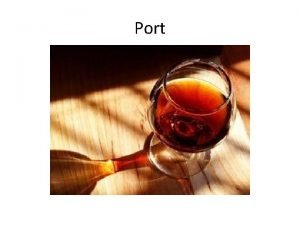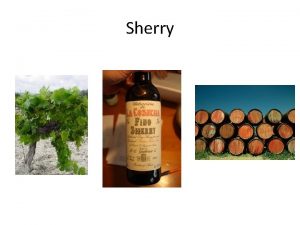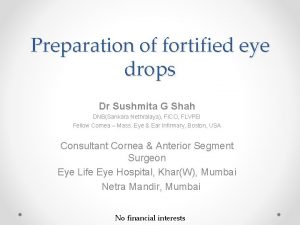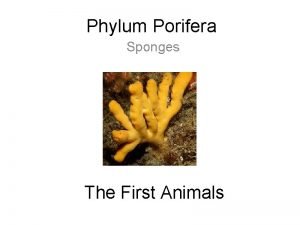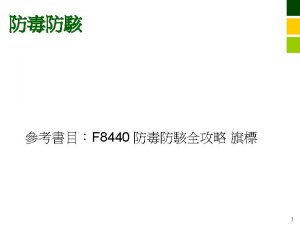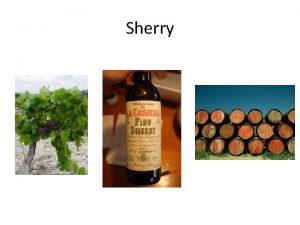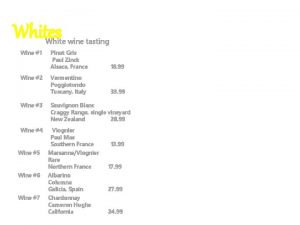Port Port wine is a Portuguese fortified wine





























- Slides: 29

Port

• Port wine is a Portuguese fortified wine produced exclusively in the Douro Valley in the northern provinces of Portugal

• The wine is fortified by the addition of a neutral grape spirit known as aguardente in order to stop the fermentation and to boost the alcohol content

• The wine is then stored and aged, often in barrels stored in a cave before being bottled.

• Over a hundred varieties of grapes are sanctioned for port production, although only five (Tinta Barroca, Tinta Cão, Tinta Roriz (Tempranillo), Touriga Francesa, and Touriga Nacional) are widely cultivated and used.

• All Ports commercially available are from a blend of different grapes

• Port from Portugal comes in several styles, which can be divided into two broad categories:

• Wines that have matured in sealed glass bottles, with no exposure to air, and experience what is known as "reductive" aging. This process leads to the wine losing its color very slowly and produces a wine which is smoother on the palate and less tannic.

• Wines that have matured in wooden barrels, whose permeability allows a small amount of exposure to oxygen, and experience what is known as "oxidative" aging. They too lose color, but at a faster pace. They also lose volume to evaporation (angel's share), leaving behind a wine that is slightly more viscous.

Tawny Port • Tawny ports are wines, made from red grapes, that are aged in wooden barrels, exposing them to gradual oxidation and evaporation

• As a result, they gradually mellow to a golden-brown color. The exposure to oxygen imparts "nutty" flavours to the wine, which is blended to match the house style.

• Tawny ports are sweet or medium dry and typically consumed as a dessert wine

• When a port is described as tawny, without an indication of age, it is a basic blend of wood aged port that has spent at least two years in barrels.

• Above this are tawny with an indication of age which represent a blend of several vintages, with the nominal years "in wood" stated on the label. The official categories are 10, 20, 30 and over 40 years.

• The categories indicate a target age profile for the ports, not their actual ages

Ruby Port • Ruby port is the cheapest and most extensively produced type of port. After fermentation, it is stored in tanks made of concrete or stainless steel to prevent oxidative aging and preserve its rich claret color.

• The wine is usually blended to match the style of the brand to which it is to be sold. The wine is fined and cold filtered before bottling and does not generally improve with age.

Vintage Port • Vintage port is made entirely from the grapes of a declared vintage year and accounts for about two percent of overall port production.

• Not every year is declared a vintage in the Douro. The decision on whether to declare a vintage is made in the spring of the second year following the harvest. The decision to declare a vintage is made by each individual port house, often referred to as a "shipper".

• While it is by far the most renowned type of port, from a volume and revenue standpoint, vintage port actually makes up only a small percentage of the production of most shippers.

• Vintage ports are aged in barrels for a maximum of two and a half years before bottling, and generally require another ten to forty years of aging in the bottle before reaching what is considered a proper drinking age.

• Since they are aged in barrels for only a short time, they retain their dark ruby color and fresh fruit flavours. Particularly fine vintage ports can continue to gain complexity and drink wonderfully for many decades after they were bottled.

• It is not unknown for 19 th century bottles to still be in perfect condition for consumption.

Single quinta vintage port • Single quinta vintage ports are wines that originate from a single estate, unlike the standard bottling's of the port wine houses which can be sourced from a number of quintas

Storing and Serving • Port, like other wine, should be stored in a cool but not cold, dark location (as light can damage the port), with a steady temperature (such as a cellar), laying the bottle on its side if the bottle has a cork, or standing up if stoppered.

• Once opened, port generally lasts longer than unfortified wine but is still best if consumed within a short period of time. Those with stoppers can be kept for a couple of months in a dark place, but if it has a cork it must be consumed sooner. Typically, the older the vintage, the quicker it must be consumed

• Exposure to oxygen (or oxidation) causes wine to deteriorate after opening. Therefore the longer a port spent in barrels (where it is exposed to air), the longer it will last after opening. A tawny port has already incorporated oxidation into its flavor profile so it will last much longer than a vintage port

Ruby Port Food Pairing • Dessert: Dark Chocolate, Chocolate Cake, Chocolate Truffles, Strawberries Covered in Chocolate • Cheese: Stilton, Dorset Blue, Camembert, Brie, Roquefort, Waterloo • Fruits & Nuts: Walnuts, Roasted Chestnuts

Tawny Port Food Pairing • Dessert: Crème Brulee, Apple Pie, Pecan Pie, Vanilla Ice Cream, Almond Biscotti, Tarts, Mince Pies. • Cheese: Cheddar, Parm, Pyrenean • Fruits & Nuts: Cherries, Almonds, Hazelnuts, Plums, Apricots, Apples, Raisins, Figs
 Portuguese fortified wine
Portuguese fortified wine Tulip shaped sherry glass
Tulip shaped sherry glass Fortified bakery products industry
Fortified bakery products industry Examples of relic boundaries
Examples of relic boundaries Vitamin d fortified milk
Vitamin d fortified milk Minoan architecture is characterized by fortified citadels.
Minoan architecture is characterized by fortified citadels. Fortified eye drops preparation pdf
Fortified eye drops preparation pdf Read and write signals in 8255 are tri state
Read and write signals in 8255 are tri state Control words of 8255
Control words of 8255 Hfss wave port size
Hfss wave port size Portuguese sailor
Portuguese sailor Dot in portuguese
Dot in portuguese What is supersition
What is supersition Man of war habitat
Man of war habitat Portuguese man of war habitat
Portuguese man of war habitat Portuguese christmas songs
Portuguese christmas songs Siya ay isang portuguese
Siya ay isang portuguese How many gifts were in the 12 days of christmas
How many gifts were in the 12 days of christmas Portuguese dewy pine
Portuguese dewy pine Portuguese pronouns
Portuguese pronouns Jos macau
Jos macau Porifera gastrovascular cavity
Porifera gastrovascular cavity Portuguese man of war habitat
Portuguese man of war habitat Toefl reading exercises
Toefl reading exercises Portuguese to spanish
Portuguese to spanish Language
Language Polymorphism in hydrozoa
Polymorphism in hydrozoa Native americans
Native americans Portuguese superstitions
Portuguese superstitions Baroque portuguese word
Baroque portuguese word
